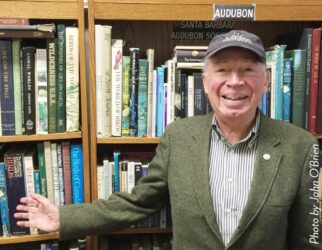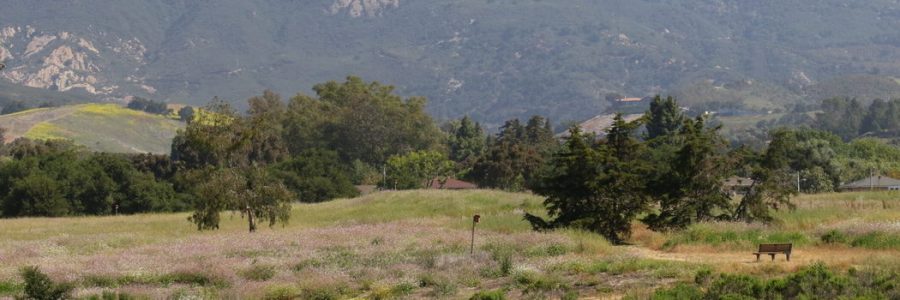
By Isabelle Walker, former SBAS board member and editor of El Tecolote
[Editor’s note: This is the full article referred to on page 6 of El Tecolote September-November 2021.]
A decade after I met Lee Moldaver in the offices of The Santa Barbara Independent, he asked me to serve as editor of the Santa Barbara Audubon Society’s bimonthly newsletter, El Tecolote. Novice birder that I was, editing El Tecolote sounded like a fun way to learn about birds while supporting Audubon’s mission. Very soon, thanks to Lee’s legendary recruiting skills, I was up to my elbows in Santa Barbara Audubon’s history, compiling an abbreviated version for members to read in El Tecolote.
Lee helped arrange interviews with chapter founders Jan Hamber and the late Joy Parkinson, as well as with past presidents like Sally Walker, Ron Hirst, and Rob Lindsay. But never once did he point to his own contributions to the chapter, which, after 22 years on its board (30 years at the time of his death) including three terms as president, were prodigious and diffuse. Only from other board members did I learn of the activist training workshops he arranged with Sally Walker in 1994, inviting environmentalists from all over the state to come here and impart their trade secrets. And that he successfully lobbied his connections at National Audubon for Santa Barbara to be selected as the site of an Audubon-inspired pilot solid waste recycling project. When the project got underway, Santa Barbara vaulted to the forefront of the nation in recycling innovation.
Right after taking over as SBAS chapter president in 1992-1993, Sally Walker drove to the Western Regional Audubon conference with then-vice president Lee. They had never worked together before, and she knew having a good relationship with Lee would be pivotal to her success as president. The trip put an end to every concern about how their collaboration would go. “He and I became not only allies but friends, and it was just unforgettable. In fact, the car broke down on the way up and we basically hung out and developed an understanding and rapport.” At that conference they decided to make watershed preservation a chapter priority and expand the chapter’s birding trips and education programs.
I don’t know how Lee operated on the myriad other nonprofit boards he belonged to, but it’s hard to imagine he was any different than he was at SBAS: forward thinking, generous-spirited, remarkably effective, and tireless.
Dave Davis, former head of the Santa Barbara Community Development Department and current Chair of the Santa Barbara Metropolitan Transit District (MTD), whose board Lee sat on for over 20 years, said Lee was deeply involved in developing the policies that brought the electric shuttle system to downtown and later to the waterfront at a time when electric shuttles were a revolutionary idea. Lee helped form an institute to study electric transportation at MTD—the Electric Technology Institute. Most of the cities that invested in electric shuttle services at that time ultimately abandoned them. Only Santa Barbara and Chattanooga, TN, made a commitment to stick with their electric fleet. Today, Santa Barbara is on track to have an all-electric fleet by 2030.
There was so much more Lee did. His knowledge base was so broad, when he advocated for a land-use, conservation, or water quality issue, he wouldn’t be thinking only of Audubon, he’d be thinking of all the players, and nudging and bringing parties together. He was, in the words of Sally Walker, a catalyst. But a quiet one.
“I can tell you from my years at city planning and community development that Lee participated in all major land-use decisions through the 80s, 90s, and into the 2000s,” Davis said. “From coastal plan to downtown revitalization, Paseo Nuevo, and housing issues, it didn’t matter, Lee was involved, basically [he] was always one of the people at the dais giving us sage advice.”
He was funny too. At community functions in the 1980s and early 90s, he would write Tom McClintock on his name tag. McClintock, our Republican State Senator from 1982-1992, rarely if ever showed up at community events. By standing in for him, Lee was pointing out how our Republican senator was missing in action. “It was an inside political joke, but I liked it,” said David Pritchett, who served on several environmental boards with Lee.
After I had to move on from El Tecolote, I didn’t see Lee regularly but would run into him often at Gold’s Gym after 9 p.m. He would be at the public computer right by the door, returning emails before working out and never failed to stop what he was doing to find out how my life was going. And at some point, he’d slip a compliment in, something greatly exaggerated that, even so, made me feel more than I was and better than I had been ten minutes earlier. And that was, of course, his intention. This is how he was with friends, male and female, always heaping praise and leaving folks better for having encountered him.
I don’t think any of us realize yet how much we have lost in the passing of Lee Moldaver. His institutional memory, of course, his extraordinary networking and consensus building skills, no doubt. I will miss his generous spirit most of all, his near reflexive way of uplifting people, of reminding us of our individual value, and in this way subtly encouraging us to keep going, because whatever it is we are doing for the community, for our families, or for the world, is important and helpful to our communal project.

